Exploring the Unique Characteristics of Whiskey Bottles
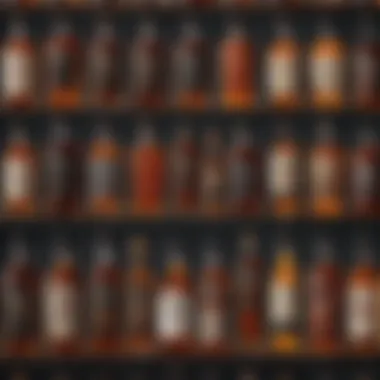

Intro
Whiskey bottles—those alluring vessels of amber delight—offer a peek into a world that marries tradition with craftsmanship. The story of whiskey extends far beyond the liquid. It encompasses the meticulous choices made by distillers, the artistry of branding, and even the cultural nuances that shape each bottling. When you raise a glass of whiskey, you’re not just savoring flavors but also exploring a rich tapestry of history and innovation.
In this article, we will take a closer look at the various types of whiskey bottles, each with its own unique characteristics and production methods. From the smoky allure of Scotch to the sweet embrace of Bourbon, every bottle tells its own tale. We’ll examine how design and branding play a critical role in consumer choice and appreciation. Moreover, we’ll outline tasting notes and potential pairings that can enhance your whiskey experience.
This examination promises to enrich both passionate enthusiasts and casual drinkers alike, pulling back the curtain on what makes whiskey bottles not just containers, but artifacts of culture and history.
"A bottle of whiskey is more than just a drink; it's a portal into the world of flavors and memories."
Whether you’re a seasoned connoisseur or a newcomer eager to learn, understanding whiskey bottles opens up exciting avenues of exploration—so let’s embark on this journey to discover their myriad facets.
Intro to Whiskey
Whiskey’s world is as rich and varied as the liquid itself. From the golden hues of Scotch to the smoothness of Bourbon, the complexities of whiskey beg for exploration. This section lays down the groundwork for understanding this beloved spirit.
Why Is Whiskey Important? Whiskey isn't just a beverage; it's a culture, an art form, and often intertwined with history and geography. Each bottle tells a story, not just of taste but of tradition, craftsmanship, and dedication. Knowing about whiskey helps in appreciating its nuances, whether one is a seasoned aficionado or just starting out.
Specific Elements to Consider When diving into the realm of whiskey, several key elements come into play:
- Ingredients: The type of grains used plays a significant role in defining flavor, whether it’s barley for Scotch or corn for Bourbon.
- Distillation and Aging: The techniques and duration of aging can modify the taste and quality.
- Regional Influences: Each whiskey-producing region contributes unique flavors due to local climate and resources.
Understanding these aspects enriches one's experience and appreciation, which is essential for anyone looking to dive deeper into the complexities of whiskey.
Defining Whiskey
Whiskey (or whisky, depending on the region) is distilled from fermented grain mash. Common grains include barley, corn, rye, and wheat. Each type of grain lends its own characteristics to the final product. Whiskey falls into various categories, primarily distinguished by the ingredients and methods used in its production. Briefly put, whiskey is a broad term that encompasses diverse styles and flavors, each with its own identity.
History and Evolution of Whiskey
The story of whiskey is decades, even centuries, in the making. It weaves through multiple countries and cultures, each contributing its chapter.
The origins trace back to at least the 15th century, with monks in Ireland and Scotland being credited for its creation. They found that distilling fermented grains into a higher-alcohol spirit was not just possible but a worthy endeavor.
Generations later, the craft of whiskey-making has evolved, encompassing a range of techniques that reflect innovation while honoring tradition. Each era brought new practices, innovations in distillation, and changing tastes. The popularity of whiskey, particularly in the United States during the 18th century, led to the birth of Bourbon; meanwhile, scotch remained a staple in the UK.
The ongoing fascination with whiskey results not only from its intriguing history but also from its adaptability. Brands and distillers continuously experiment with ingredients and processes, ensuring the landscape of whiskey is vibrant and continually evolving.
"Whiskey is liquid sunshine that flows through the veins of culture and tradition."
Ultimately, knowing the history of whiskey enriches the drinking experience. It’s not just about sipping; it’s about savoring centuries of craft. Readers now have a better grasp of whiskey's significance, its definitions, and its fascinating history, setting the stage for the exploration of different whiskey bottle types in the following section.
Types of Whiskey Bottles
Understanding the various types of whiskey bottles is crucial. Each category reflects unique characteristics, flavors, and traditions that guide consumers, whether they are seasoned connoisseurs or newcomers just starting their journey. Different types of whiskey bottles often indicate not just the spirit within but also the story that accompanies it, making it an essential aspect to explore. Awareness of these distinctions can enhance the tasting experience, providing insight into what to expect in terms of flavor, aroma, and overall quality. Furthermore, the design of the bottle itself can also communicate much about the whiskey's heritage and branding strategy, influencing consumer preferences significantly.
Scotch Whiskey
Single Malt Scotch
Single Malt Scotch represents the pinnacle of craftsmanship. Made from 100% malted barley and distilled at a single distillery, it offers a rich tapestry of flavors that vary based on regional characteristics and production techniques. One key characteristic of Single Malt Scotch is the complexity of flavors that emerge during the fermentation and aging processes. The benefit of drinking Single Malt Scotch lies in its diverse tasting notes, ranging from fruity and floral to smoky and peaty. This variety means that each bottle is often a reflection of its distillery's unique methods and location.
A unique feature of Single Malt Scotch is its age statement, commonly found on the label. This indicates how many years the whiskey has spent aging in the cask, often correlating with its depth of flavor and overall quality. However, one disadvantage can be the price point; quality Single Malt Scotches can be a bit pricey, which might be a deterrent for some.
Blended Scotch
On the other hand, Blended Scotch offers a different experience. It combines malt whiskeys from various distilleries with grain whiskeys, resulting in a smoother, more approachable taste. The key characteristic of Blended Scotch is its consistency, as producers blend different batches to achieve a balanced flavor profile year after year. This makes it a popular choice for those who may be hesitant to explore the more robust flavors of Single Malt.
The unique element here is the variety of flavors that can be achieved through blending, bringing together the strengths of various whiskeys. However, one might argue that this can lead to a dilution of the distinct characteristics found in single malts. Still, the appeal of Blended Scotch lies in its broad accessibility and the way it can appeal to a wide range of palates.
Bourbon
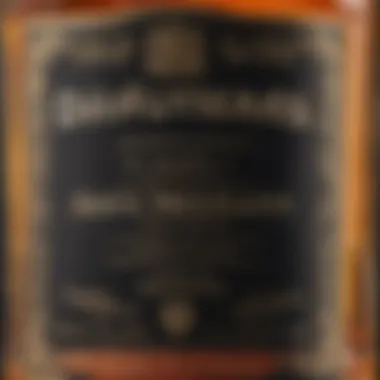
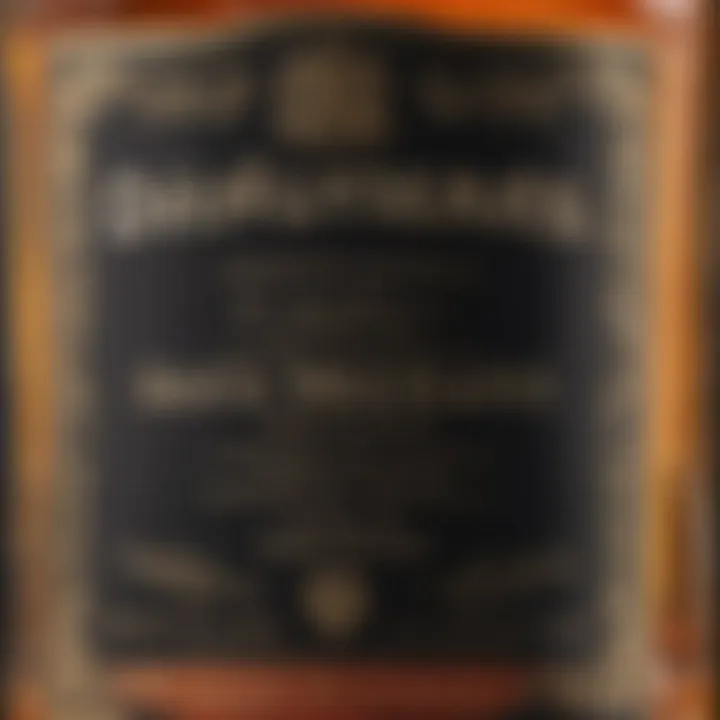
Straight Bourbon
Straight Bourbon is a staple of American whiskey, characterized by its majority corn mash bill (at least 51%). The importance of Straight Bourbon lies in its adherence to strict regulations that define its quality. A key feature is that it's aged for a minimum of two years in new charred oak barrels, giving it a caramel and vanilla-forward profile. Because of these qualities, it stands out as a favorite for many whiskey enthusiasts.
One unique aspect of Straight Bourbon is its potential for craft variation, as producers can infuse personal touches in flavor and aging. This can lead to a delightful range of tastings. However, some may find that bourbon's sweeter notes can overshadow the complexity found in other whiskey styles, a factor to consider when choosing a bottle.
Small Batch Bourbon
Small Batch Bourbon is another intriguing option. This type of bourbon is produced with a limited number of barrels, often resulting in unique flavor profiles not found in larger, mass-produced varieties. The key characteristic here is the craftsmanship involved; small batch producers pay careful attention to the selection of barrels and how they interact with the spirit. This careful selection leads to a product that can offer more exciting and nuanced flavors.
While Small Batch Bourbon is lauded for its quality, it often comes at a higher price. The limited availability makes it harder to find, and its quality can vary between batches, posing a challenge for those seeking consistency. Still, for adventurous drinkers, this is often considered a rewarding choice.
Irish Whiskey
Single Pot Still
Single Pot Still whiskey offers an authentic Irish experience, made from a mix of malted and unmalted barley distilled in a pot still. The complexity of flavors found here makes it a noteworthy example of traditional Irish whiskey. A standout aspect is its creamy and spicy notes, which are rare in other whiskey types. This variety is appealing, showing a different side of Irish whiskey that can captivate drinkers seeking something unique.
A unique feature of Single Pot Still is its smooth mouthfeel and often robust flavor, which can vary based on distillation practices. However, its distinctiveness might sometimes come off as challenging for those who are more accustomed to the smoother notes of blended whiskeys. Still, for those who enjoy exploring deep flavors, Single Pot Still is a cherished choice.
Blended Irish Whiskey
Blended Irish Whiskey serves as a fantastic introduction to this category, providing a harmonious mix of both pot still and column still whiskeys. The balance of flavors makes it widely popular. A prominent characteristic is its lightness and drinkability, which makes it a hit among many settings, from sipping neat to mixing in cocktails.
The unique feature of blended variations is their ability to offer something for everyone, whether they prefer a smooth finish or a hint of spice. However, some whiskey enthusiasts might find that the blend lacks the complexity seen in Single Pot Still options. Regardless, its accessibility and adaptability keep it at the forefront.
Canadian Whiskey
Canadian Rye
Canadian Rye is an iconic whiskey style that often highlights rye's spicy characteristics, even in blends where it may not be the majority grain. A pivotal aspect is the richness of flavor, often boasting notes of fruit, spice, and a touch of sweetness. Its versatility allows for creativity in cocktails, making it a favored choice among mixologists.
The unique feature of Canadian Rye is its ability to vary greatly depending on producer methods. This variance can be both an advantage and disadvantage, as consumers may find different flavor profiles depending on the brand and batch. Still, for those who appreciate rye, this presents an exciting opportunity to discover new favorites.
Blended Canadian Whiskey
Blended Canadian Whiskey can often be lighter and more approachable. Its hallmark is a smooth finish, derived from blending various whiskey types, which provides a wider audience appeal. The primary characteristic is its versatility, lending itself to a variety of uses from sipping to mixing.
A unique aspect of blended Canadian whiskey is how it can combine flavors and aromas from multiple regions, often resulting in a more complex and layered experience than newcomers might expect. While this broad flavor spectrum might lack the depth of a single malt, it serves as an inviting way for newcomers to explore whiskey.
Japanese Whiskey
Single Malt Japanese Whiskey
Japanese whiskey, particularly single malts, has been gaining notoriety for their balance and precision. A unique feature of Single Malt Japanese Whiskey is its meticulous production methods, often mirroring those of Scotch, yet offering a distinctly different flavor profile—elegant, refined, and often with floral notes. This refinement makes it a pristine choice for those looking to enjoy something extraordinary.
The craftsmanship involved in making Single Malt Japanese Whiskey is usually highlighted in the attention to detail and quality, making it desirable among collectors. One downside might be its price, often higher than other types due to its less widespread availability. Despite this, the pursuit of quality makes it an attractive option.
Blended Japanese Whiskey
Blended Japanese Whiskey presents another perspective, meshing different distillation methods and flavors for a harmonious experience. The characteristic smoothness found in blended varieties makes it accessible for beginners, often leading to a universal appeal. Its blending technique allows for a broader flavor range.
A crucial feature is its versatility; blended Japanese whiskey can be enjoyed neat, on the rocks, or in cocktails. However, some aficionados might argue that blending dilutes the uniquely Japanese craftsmanship seen in single malts. Still, its widespread appeal ensures it remains a staple in whiskey culture.
Production Process of Whiskey
Understanding the production process of whiskey is crucial for anyone who wants to grasp the essence of this beloved spirit. Every stage influences the final product's flavor, aroma, and texture. It's not just about the end result; it’s about appreciating the nuances that come from the soil, the water, and the hands that craft it. Each step, from mashing to aging, adds a layer of complexity that leaves a lasting mark on the drinker’s palate. Let's break down these critical stages:
Mashing and Fermentation
Mashing is the first step in whiskey production, involving the mixing of grains with hot water. This process activates enzymes in the malted grain that convert starches into fermentable sugars. When the grain is mixed well, it creates a sweet liquid known as wort. This is where the magic begins.
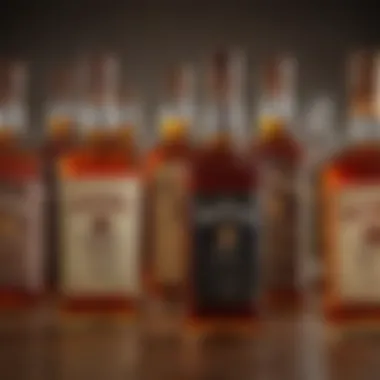
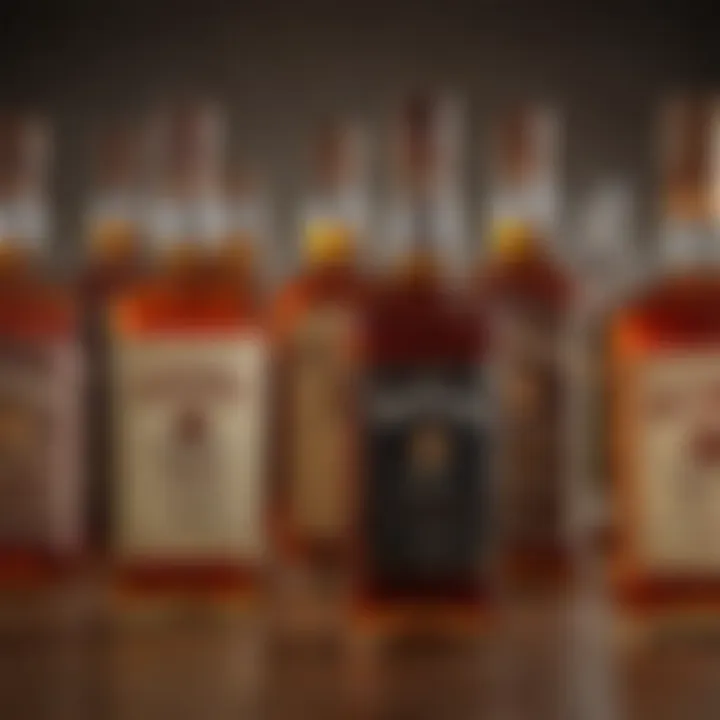
Fermentation follows, where yeast is introduced to the wort. The yeast consumes the sugars, producing alcohol and carbon dioxide in a delightful dance of transformation. This stage can last several days, and it's here that certain flavors start to take shape, influenced by the type of yeast and duration of fermentation. The characteristics of the resulting wash are vital, as they set the foundation for all that comes next.
Distillation Techniques
Once fermentation is complete, distillation comes into play. This is where the alcohol content is increased and refined, separating the spirit from the water and unwanted impurities. Most distilleries employ either pot stills or column stills.
- Pot Stills: In traditional whiskey-making, pot stills are favored for their ability to produce richer flavors. The wash is heated in the still, and the alcohol vapors rise and condense, resulting in a spirit that carries complex characteristics.
- Column Stills: These are more common in large-scale production, providing a continuous flow of distillation. This method results in a cleaner and higher proof spirit, often used for blending.
Each method offers distinct aromas and taste profiles, and the choice ultimately impacts the style of whiskey produced.
Aging and Maturation
Aging is perhaps the most captivating phase of whiskey production. After distillation, the spirit is transferred to wooden barrels, typically made from oak. This wood doesn’t just hold the liquid; it interacts with it over time, adding depth and character. The aging process can last anywhere from three years to several decades, depending on the desired flavor profile.
As the whiskey sits in the barrel, it absorbs compounds from the wood, acquiring notes of vanilla, caramel, and spices. Additionally, the climate plays a pivotal role here; whiskey in warmer regions tend to age faster due to the increased interaction with the barrel. Conversely, whiskey aged in cooler climates generally takes longer to mature, often resulting in more complex and nuanced flavors.
"Aging transforms raw spirit into a refined whiskey, creating a bridge between the past and present with every sip."
In summary, the production of whiskey is a meticulous process involving distinct steps—mashing, fermentation, distillation, and aging. Each phase builds upon the last, weaving a tapestry of flavors designed to tell a story in every glass. Understanding this journey not only enhances appreciation for the drink but also invites enthusiasts to explore the intricate world of whiskey in all its forms.
Factors Influencing Whiskey Flavor
When diving into the intriguing realm of whiskey, you quickly realize that it is much more than just a drink. The flavors found in whiskey are a tapestry woven from various elements, each leaving an indelible mark on the final product. Understanding these factors enables enthusiasts and newcomers alike to appreciate the nuances that make each bottle special.
It’s important to contemplate how certain variables bring unique character and depth to different whiskeys. Here’s a closer look at three of the key aspects that shape the flavor profile: grain type, water source, and the environment.
Grain Type
The foundation of any whiskey begins with its grain. Whether it’s barley, corn, rye, or wheat, the choice of grain plays a pivotal role in defining not only the flavor but also the texture and aroma of the spirit. Different grains bring out various qualities. For instance, corn tends to impart a sweeter and fuller mouthfeel, commonly found in bourbons. In contrast, rye adds spice and complexity, creating a more robust experience.
- Barley: Often a staple in Scotch whiskey, it can showcase malty sweetness alongside fruity notes.
- Wheat: This grain often smooths out the harsh edges, introducing subtle sweetness, commonly seen in softer bourbons or wheated rye.
This delicate balance of flavors derived from grains can make whiskey approachable or challenging, depending on what is used. The art of blending different grains is truly a craft, affecting not only flavor but also the overall experience of savoring a pour.
Water Source
Water is often an overlooked factor in whiskey production. However, it holds immeasurable significance. The mineral content and purity of water can dramatically alter the taste of whiskey. Distilleries often choose specific water sources that not only hydrate but also enhance the overall profile of the whiskey.
For example, soft water may yield a lighter style of whiskey, whereas hard water can intensify the flavors, leading to a more pronounced character.
- Mineral Content: Differences in calcium, magnesium, and iron can cause subtle shifts in flavor.
- Source Origin: Distilleries close to natural springs often capitalize on fresh, pure water to maintain flavor integrity.
The interaction of water with the whiskey during the process of mashing and dilution can foster a depth of flavor that is difficult to replicate.
"In whiskey, the right water is as critical as the right grain; it carries everything smoothly into the glass."
Environment and Climate
The environment in which whiskey is produced also leaves its mark. Factors such as climate, temperature variations, and humidity can profoundly affect the aging process. Whiskey barrels breathe in the surrounding air, leading to interactions that impart distinctive qualities over time.
- Climate: Warmer climates tend to encourage more rapid maturation. The wood expands and contracts, allowing the whiskey to mingle with the charred barrel, absorbing flavors faster.
- Humidity: Fluctuating humidity levels can influence how whiskey evaporates, known as the "angel's share." Dry conditions might lead to higher concentrations of flavor, while more humid environments can yield a softer spirit.
The geographical uniqueness of a distillery—be it in the rolling hills of Scotland or the sun-kissed valleys of Kentucky—adds a personal touch to each bottle, making it more than just another spirit on the shelf.
In summation, it’s imperative for whiskey lovers to bear in mind that flavor is not solely defined by production methods or aging times. The grains, water, and environment intertwine to create a multifaceted experience in every sip. By delving deeper into these factors, consumers enhance their appreciation for this historical and evolving spirit.
Understanding Whiskey Bottles and Labels
When we talk about whiskey, we often think of the taste and the aroma but getting a grasp on the bottles and their labels can be just as crucial. The bottle isn't just a container; it's the first impression of the whiskey inside. Understanding whiskey bottles and their labels helps consumers navigate through a sea of choices, discerning the quality, tradition, and character before even taking a sip. It’s like judging a book by its cover—while you shouldn't solely rely on it, it certainly provides vital clues about the story within.
Bottle Design Elements
The design of whiskey bottles can sometimes feel like an art form. The curvature, the label layout, and even the cap can tell you a whole lot about the whiskey you’re considering. Here are what to look for:
- Shape and Size: Traditional whiskey bottles often have a rectangular boldness, which can imply a more classic product. Conversely, unique shapes might hint at a craft distillery trying to stand out from the crowd.
- Label Quality: Glossy labels might scream mass production, while textured, matte labels could imply a premium or craft spirit. The graphics, fonts, and designs often reflect the heritage behind the whiskey, giving hints of its origin.
- Closure Type: A cork finish can suggest a more upscale product, whereas a screw cap might be perceived as standard. But, don't be quick to judge; some high-quality whiskeys come with screw caps for practicality.
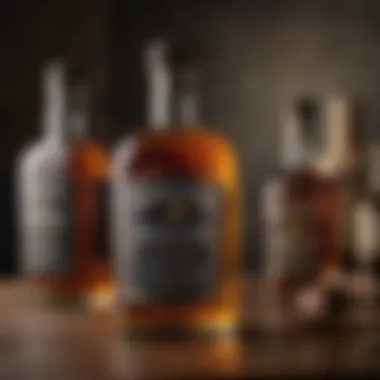
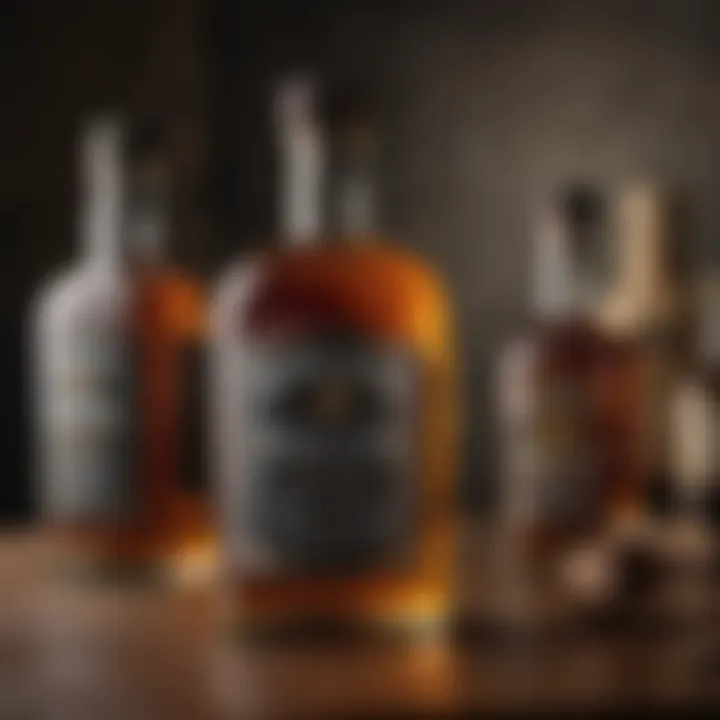
Overall, every part of a bottle's design can lead to a deeper appreciation of the whiskey itself, offering context that enhances the drinking experience.
Reading Labels: What to Look For
Just as a detective searches for clues, reading whiskey labels requires a keen eye. Labels can be packed with information that affects consumer decisions. Here’s what to pay attention to:
- Alcohol By Volume (ABV): This tells how strong the whiskey is. A higher ABV doesn't always mean better; it can indicate a bolder flavor but also might make it less approachable for some.
- Age Statement: An age on the label indicates how long the whiskey has been aged in barrels. While some older whiskeys can command a higher price, age isn't always synonymous with quality; some younger expressions can be exceptional.
- Origin: Knowing where the whiskey comes from is crucial. Whether it's Scotch, Bourbon, or Japanese whiskey, the origin influences flavor profiles due to different distillation and aging processes. It’s like trying authentic Italian pizza versus a chain restaurant; location and tradition make all the difference.
- Ingredients: Some labels will also tell you about the mash bill, which can be enlightening. Is it a blend, or does it feature a predominant grain? This can guide you in choosing what best suits your palate.
The Role of Branding in Whiskey
Branding plays a pivotal role in shaping the whiskey market. It's not merely about a label or a catchy slogan; it’s a complex tapestry woven from history, identity, and consumer sentiment. In a world crowded with distilleries, the brand becomes the compass guiding enthusiasts and novices alike towards their chosen bottle.
The significance of branding in whiskey hinges on several elements. Firstly, it establishes a narrative that resonates with buyers. Each brand carries its own story, often steeped in tradition and authenticity. This narrative can be incredibly influential, stirring emotions and memories associated with particular whiskey experiences. Moreover, branding cultivates trust. In this saturated market, consumers lean towards names they know, believing in the quality and experience that those brands promise.
Another consideration is how branding aligns with contemporary trends and changes. Some brands might reinvent themselves to appeal to a new demographic while still holding onto their legacy. The interplay of heritage and innovation can sometimes create a winning strategy that brings in fresh faces while keeping loyal customers satisfied.
Brand history and heritage
Examining the history and heritage of a whiskey brand offers a fascinating glimpse into its values and ethos. Many whiskey brands have roots that extend deep into the past. Take Glenfiddich, for example, established in 1887. Its branding embodies craftsmanship that reflects not only in the product but also in the presentation. Tales of family recipes and generations of knowledge contribute to a rich backstory that enhances the overall appeal.
- Heritage: Distilleries often embrace their historical lineage wholeheartedly. It's not uncommon for brands to showcase their old buildings, traditional production methods, and long-standing relationships with local suppliers to communicate stability and reliability.
- Craftsmanship: Highlighting how whiskey is made can be just as compelling. Brands communicating their unique distillation processes or aging techniques often capture the attention of aficionados who value quality over mass production.
Moreover, limited releases and special editions—often labeled with care—serve as a testament to the brand's commitment to quality and exclusivity, which can excite collectors and enhance brand perception.
Consumer Perception and Loyalty
Consumer perception and loyalty are deeply intertwined with branding in the whiskey sector. A well-crafted brand cultivates a distinct image in the minds of consumers, influencing not just purchase decisions, but also emotional connections.
- Trust: Consumers prefer buying from brands that have established credibility over time. A brand's ability to consistently deliver quality reinforces customer trust.
- Community Engagement: Many whiskey brands go beyond just selling products. They craft communities—through social media campaigns, distillery tours, or tasting events—that engage whisky drinkers and enthusiasts. This connection elevates the mere act of drinking whiskey into a shared experience.
The loyalty that stems from positive consumer perception can be quite remarkable. Once consumers identify with a brand, they often advocate for it, sharing their passion within social circles. This word-of-mouth marketing tends to be some of the most effective. More than just repeat purchases, loyal customers become brand ambassadors, often extolling the virtues of their chosen whiskey, further solidifying the brand's place in the whiskey landscape.
Tasting Whiskey: A Sensory Experience
Tasting whiskey is not merely about quenching thirst; it’s a multi-layered journey that brings together the senses in a delightful symphony. The experience starts long before the first sip. As one uncorks a bottle, the rich, warming aroma wafts through the air, igniting anticipation. Understanding this sensory experience is vital for any enthusiast, whether you're sipping on a fine Scotch or a smooth Bourbon. Not only does tasting whiskey heighten appreciation for the spirit, but it also enhances the ability to recognize the complexities involved in its crafting.
When we speak of tasting whiskey, we delve into a world filled with unique elements that many overlook. This communion with the senses can potentially transform a casual drink into an enlightening exploration of flavor, history, and craftsmanship. There’s an entire framework involved—each nuanced note open to scrutiny and deliberation, lending itself to a deeper understanding of what’s in the glass.
Identifying Tasting Notes
To effectively appreciate the depth of whiskey, identifying tasting notes is essential. Each sip of whiskey carries a narrative—a blend of flavors and aromas that evolve continuously. Common categories of tasting notes often center around:
- Fruity: Finding notes of raisins, apples, or citrus can hint at the maturation process or the type of barrels used.
- Spicy: Notes of cinnamon, nutmeg, or clove might speak to the grains used or the distilling method.
- Woody: Oak, cedar, or birch often tell tales steeped in the aging process.
- Sweet: Caramel, honey, or vanilla provide insight into sugar content or additional flavoring.
Tasting notes should be approached with an open mind. Allowing the whiskey to linger on your palate can reveal subtler flavors, and an attentive nose can unveil hidden aromas. As one deepens their exploration into these notes, the relationship with whiskey entirely transforms.
Pairing Whiskey with Food
Whiskey and food pairing can unlock new dimensions, enhancing both culinary experience and the appreciation for whiskey itself. The interplay of flavors can either elevate a dish or harmonize with it. Some considerations include:
- Complementing Flavors: Choosing a whiskey that shares similar notes with a dish enhances the overall experience. For example, a smoky Islay Scotch pairs well with grilled meats, echoing smoky flavors in both.
- Contrasting Elements: On the other hand, opposites might attract. A sweet Tennessee whiskey can beautifully counterbalance a sharp cheese, creating an engaging contrast.
- Textures: The mouthfeel of whiskey adds another layer to the mated experience. A smooth, rich Bourbon can soften a crunchy, fried appetizer.
Engagement with these pairings can transform a simple meal into an extraordinary event. The right combination not only satisfies the taste buds but also elevates the entire occasion, leaving an indelible mark on one's culinary recollection.
Ending
The exploration of whiskey bottles is far from a mere recreational pursuit; it embodies a deep-rooted cultural heritage and a craft honed over centuries. In this article, we navigated through various types of whiskey, each defined by unique characteristics in production, flavor, and presentation. The discussion illuminated not only the diversity of whiskey types like Scotch and Bourbon, but also the intricate processes involved from mashing to maturation.
The Ever-Evolving Whiskey Landscape
The whiskey landscape is perpetually shifting, always alive with innovation while cherishing tradition. As distilleries experiment with new techniques and flavors, whiskey enthusiasts find themselves at the crossroads of nostalgia and novelty. The evolving nature of whiskey extends beyond mere taste—it encompasses the entire experience, from the aesthetics of bottle design to the narratives each brand weaves into its offerings.
For enthusiasts, this evolution is significant. It offers a broader array of choices to suit diverse palates and social occasions. Moreover, understanding the influences behind these changes lets drinkers appreciate subtle nuances, perhaps making them more discerning in their selections.
- Sustainability: Many contemporary whiskey producers are committed to sustainable practices, reflecting a broader societal focus on environmental responsibility.
- Craftsmanship: Craft distilleries are on the rise, bringing artisanal approaches to a traditionally industrial field. Their dedication to quality shakes up the marketplace, encouraging even larger brands to rethink their processes.
An inclination for unique flavor profiles has birthed intriguing innovations such as barrel aging in rare woods or using unconventional grains. These developments keep the whiskey world vibrant and engaging. Consumers are invited to partake in this journey, with each bottle containing many stories, flavors, and meanings.
In summary, the current whiskey environment is a realm where tradition marries experimentation. Such a landscape not only satisfies the adventurous drinker but also honors the hisory, legacy, and craftsmanship behind each sip. Whether you are a seasoned enthusiast or a curious newcomer, the ever-changing world of whiskey bottles continuously offers fresh insights and flavors to explore.







